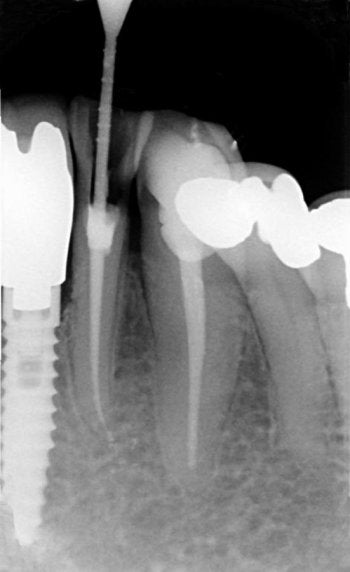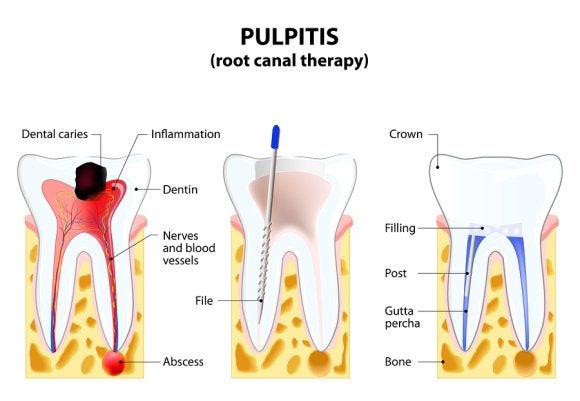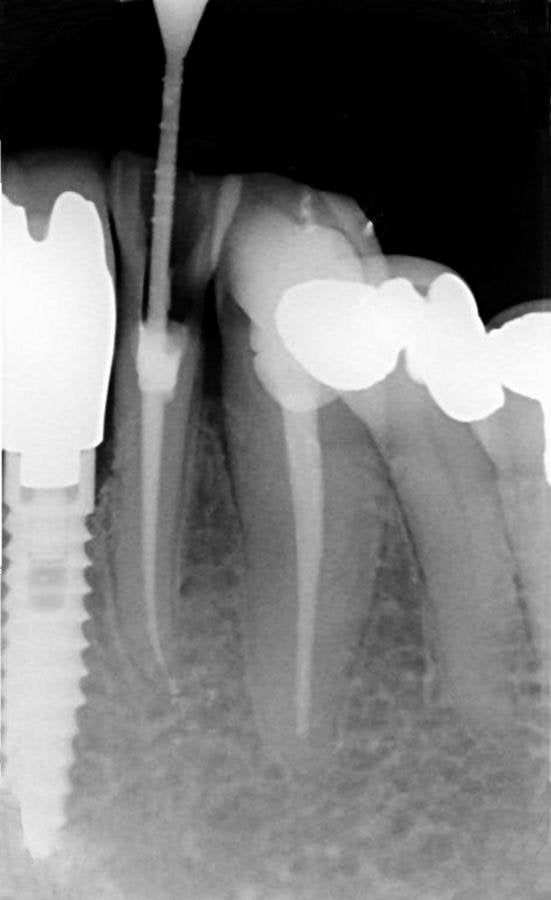-
Could Sugarless Drinks Hurt Your Teeth?
You are probably aware of the problems that sugar can cause for your teeth and gums, but switching to sugarless drinks might not be the final answer for good dental care. Remember that you should be visiting your Dr. Zhu for regular appointments as well as practicing proper dental care at home. Check out this video clip to find out if sugarless drinks could be hurting your teeth.
It is not uncommon to see advertisements for sugarless drinks that claim to be healthier than their competitors. However, switching to these sugarless drinks might not be the best idea for your dental care. Sodas, sports drinks, and other sugarless beverages might still contain acids that can attack your tooth enamel and cause decay; despite the way these drinks are advertised, this is not very friendly towards your teeth. Be sure to read the labels carefully and practice proper dental hygiene daily.
-
Understanding the Root Canal Procedure
When you visit your dental office in Bel Air, MD to receive treatment for a cavity, there are times when your dentist may recommend a root canal . Continue reading to learn more about this commonly performed dental procedure.

Allowing Cavities to Progress
Cavities occur when bacteria cause damage to the surface of a tooth and begin to penetrate the enamel. When left untreated, a dental cavity can become severe enough that bacteria can make their way into the tooth. Once a tooth becomes infected, the tissues inside can become inflamed. The swelling can cause the individual a great deal of discomfort which is frequently what leads them to see a dentist for treatment. In addition to cavities, cracked and broken teeth can also be vulnerable to infection.
Examining the Tooth
Once a tooth is infected, parts of it can become damaged and, in some cases, the swelling prevents proper blood flow to the tooth which can kill the tissues inside. When you visit your dental office for a toothache, your dentist will examine your mouth, and he may also take X-rays of the painful tooth to get a better look at the extent of the damage. Depending on how big the cavity is or what damage the infection has caused, your dentist may tell you that you need a root canal.
Performing the Root Canal
Root canals are safe procedures that are frequently performed in dentistry, and they can provide patients with relief from the pain that they are experiencing while avoiding the need to extract the tooth. First, your dentist will numb the area. Next, he will drill a hole into the tooth to remove the infected tissues inside. Then, he will treat the infection, clean out the tooth, and fill the canal with a special type of tooth filling material. Finally, your dentist will use a filling or a crown to seal the tooth and restore its dental function. The site may feel tender for a few days, but patients usually feel much better following their root canal procedure and can enjoy restored function of their tooth.
-
Preparing for Your Child’s First Dentist Appointment
Children should have their first visit to a dental office once a tooth comes in or before their first birthday to allow dentists to check the growth and development of their teeth. This initial visit is important because, as soon as her first tooth appears, it can develop a dental cavity. When you are scheduling the appointment with a pediatric dentist in Bel Air, MD, try to select a time when your child tends to be more cooperative. For many children, morning appointments work best.
On the day of her appointment, provide her with a light meal, but avoid giving her snacks in the waiting room, as this can make the examination more difficult since she is likely to have food on her teeth. Finally, if you have dental insurance, contact your provider to ensure that your child is included in the plan before her pediatric dentist appointment.
-
What Are the Signs of a Tooth Abscess?
A tooth abscess can be a very painful condition. In this video, a dental care practitioner will explain some of the common signs and symptoms of an abscessed tooth. When you have an abscess, you may find that your tooth is very sensitive to hot or cold foods. You may also feel a dull, aching pain that throbs in your mouth. A dentist at a general dentistry office in Bel Air will be able to check your tooth for the signs of an abscess.
In the event that you experience an abscess in your tooth, you will want to visit your local dental office right away. With dental care services, you will be able to alleviate your pain and restore your tooth to perfect health. Your dentist will have the tools needed to remove the abscess and improve your overall comfort.
-
What Happens During a Root Canal?
If you experience tooth pain and visit an emergency dentist near Bel Air, MD, it’s possible that your dentist will determine that the nerve of your tooth has been damaged by an infection or decay. In these situations, a root canal is indicated. A root canal can save your natural tooth and prevent the need for a tooth extraction. To perform this common dental procedure, your dentist will thoroughly numb the area and create an access opening on the top of the affected tooth. Then, the dentist inserts a series of root canal files into the opening to remove the infected pulp and other damaged tissues. Other dental instruments may be needed to address tooth decay, if this problem is also present.
Once all of the damaged material has been removed from the tooth, the dentist seals the hole with a temporary or permanent filling. In the same office visit, we will permanently seal the tooth if you received a temporary filling. Your dentist will also permanently affix a dental crown on top of the tooth. The dental crown looks just like a natural tooth; it protects the natural tooth from trauma.

-
Spotting the Signs of Gum Disease
It’s important to visit your dentist in Bel Air, MD, regularly for routine dental care, including professional dental cleanings and exams. This will give your dentist the opportunity to catch early warning signs of dental problems, such as early warning signs of gum disease . Here is a guide to spotting the signs of gum disease, so that you can quickly make an appointment at your dental clinic if necessary.

Recognizing Gingivitis, the First Stage of Gum Disease
Gingivitis is the first stage of gum disease, but its progression can be slowed or stopped with proper dental care. The warning signs of gingivitis include mild to moderate inflammation of the gums. Your gums may be red, swollen, and may bleed easily. If your dentist does not quickly treat gingivitis, it can progress to more serious stages of gum disease. Your dentist will determine the most appropriate dental care necessary for your symptoms. This may include daily brushing and flossing, using specialized prescription dental care products, and visiting your dentist regularly for dental cleanings.
More Severe Symptoms of Periodontal Disease, Also Known as Gum Disease
Without regular, daily dental care, gingivitis may progress to more serious stages of periodontal disease, which is also called gum disease. Periodontal disease causes the gums to begin to recede or pull away from the teeth. This creates pockets in the gums that can become infected with bacteria. As the infections spreads, your risk of tooth loss greatly increases. You cannot treat periodontal disease at home, but instead must visit a dentist for specialized dental care.
Signs of Advanced Periodontitis
If gum disease is untreated, it will progress to a condition known as advanced periodontitis. In this stage of gum disease, your dentist may have to perform tooth extractions to remove damaged or diseased teeth. Your tooth will then have to be replaced with a dental implant or dental bridge. Your dentist will first attempt to treat advanced periodontitis using a non-surgical dental care method known as scaling and root planing. This is basically a very intense, thorough dental cleaning during which the dentist removes plaque, tartar, bacteria, and infection from your teeth and gums. If this is ineffective, your dentist will recommend surgical dental care.
-
Save Your Tooth with a Root Canal
If you have a severely infected tooth, you may need to visit an emergency dentist in Bel Air, MD. An emergency dentist can attempt to save your tooth via a root canal procedure , rather than resorting to a tooth extraction. Root canal procedures are a safe, effective method of emergency dental care, and can prevent your infection from spreading while preserving the integrity of your infected tooth.
Prior to your root canal, your dentist will administer anesthesia. He may also give you a mild sedative to help you relax during the procedure. This will ensure that you remain comfortable and pain free throughout your dental care procedure. Once the anesthesia is in effect, your dentist will drill a small access hole into your infected tooth. He will use special dental tools to remove diseased or infected dental pulp, tooth nerve, and tissue from your tooth.
He will then fill the tooth cavity with medication to completely eradicate your infection. Then, he will seal the access hole with dental putty to prevent bacteria from entering. He may place a dental crown on the tooth to preserve its structural integrity and prevent a broken or chipped tooth.

-
Proper Flossing Technique
Do you practice proper dental care in Bel Air, MD? Your dentist has probably told you that one of the most important parts of a healthy dental care routine is flossing daily. Be sure to use a proper flossing technique in order to avoid dangerous tooth decay.
Watch this video to learn the details about proper flossing technique. Wrap about 18 inches of floss between your two middle fingers. Then, gently insert the floss between your teeth, working it up and down against the surface of each tooth. Don’t forget to floss behind your back teeth, too! Ask your dentist or local dental clinic if you have any questions about flossing when you have dental work such as a dental bridge or orthodontic appliances.
-
Treating an Abscessed Tooth
If you have an abscessed tooth, it means that the bulb of your tooth is infected. A pocket of puss forms under the tooth and is usually quite painful. The infection is caused by advanced gum disease in Bel Air or tooth decay and the infected portion of the abscessed tooth will need to be removed. To treat an abscessed tooth, a dentist in Bel Air will perform a root canal .
Watch this video to learn more about treating an abscessed tooth and what causes the infection to happen. In addition to tooth decay, a cracked tooth can also cause an abscessed tooth. A root canal is when a dentist removes the infected portion of the tooth and seals the tooth with a crown.
-
When Is a Root Canal Necessary?
There are a number of reasons you may need a root canal near Bel Air . A root canal is a procedure performed by a dentist to remove the tooth nerve. The procedure is done to save a tooth that has become infected or shows signs of bad decay. It may not always be immediately apparent when a root canal is necessary. This article will highlight some of the more common reasons a root canal would be required.
When Tooth Pain is Present
Not all tooth pain is a reason to have a root canal, but pain is a major indicator that something is wrong. If the pain is present when eating or when pressure is applied, it could be indicative of nerve damage. Extra sensitivity or pain to hot and cold is also a sign of nerve damage. If a tooth that is infected or badly decayed causes the pain, a root canal will need to be performed to stop the pain.
present when eating or when pressure is applied, it could be indicative of nerve damage. Extra sensitivity or pain to hot and cold is also a sign of nerve damage. If a tooth that is infected or badly decayed causes the pain, a root canal will need to be performed to stop the pain. If a Tooth has Become Abscessed
If a tooth that is infected is left untreated, an abscess will form. An abscess is a pocket of puss that forms in the tooth. An abscessed tooth can spread to other teeth and gums, furthering the infection. While it may or may not cause pain, an abscessed tooth is usually visually noticeable. The puss pocket that forms has an appearance similar to that of a pimple. Some patients with an abscessed tooth may even notice puss oozing from the affected area. A root canal is necessary to repair the abscessed tooth.When a Tooth has Been Damaged
Any time a tooth is damaged and the nerve is affected, a dentist will likely perform a root canal. In the event of trauma to the tooth, such as being hit in the face with enough force to damage a tooth, the nerve can be severed. If this happens, a root canal can be performed to fix the nerve.
RECENT POSTS
categories
- Uncategorized
- General Dentistry
- Toothache
- Emergency Dentistry
- Family Dentistry
- Receding Gums
- Cosmetic Dentistry
- Veneers
- Gum Disease
- Gingivitis
- Dental Crowns
- Orthodontics
- Dental Implants
- Root Canal
- Wisdom Teeth
- Teeth Whitening
- Your Smile
- Composite Fillings
- Lumineers
- Dentures
- Invisalign
- BrightSmile
- Dental Bridge
- Abscessed Tooth
- Sealants
